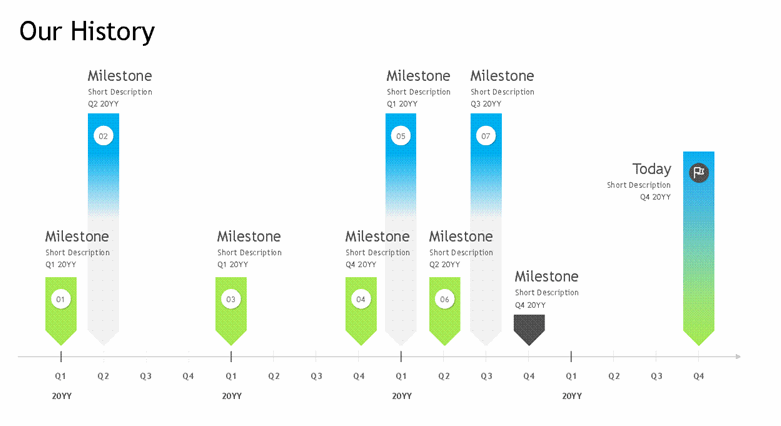What are Project Milestones and How to Create a Project Milestone?

What are Project Milestones
Every complex effort is realized through multiple steps, and it’s often wise to define these steps clearly in advance. A step can be considered complete once a certain outcome is reached, and this outcome is typically described as a milestone. Much like a real road marker, a milestone serves to provide a sense of orientation and signal progress toward a known goal.
Since each project needs a different set of milestones, it takes some skill to separate it into logical segments and clearly define the targets that have to be reached. This needs to be done in a realistic manner, as too difficult or irrelevant milestones won’t contribute to the efficient completion of the project. Once the targets are set, the managers still need to monitor all activities in order to notice immediately when a milestone is within grasp and react accordingly.
This topic deserves more attention, and we tried to present the most important definitions and explanations of project milestones as well as the skills related to their creation.
Table of Contents: hide
What are the Milestones of a Project?
Why is Project Milestones Important?
What are the Milestones of a Project?
This term simply denotes critical events or accomplishments that indicate progress along the projected workflow. Almost anything can be a milestone, if it can be precisely defined and impartially measured. For example, executing a set of activities or achieving an advanced stage in product development can be considered typical milestones.
Alternatively, a milestone could be tied to sales figures, number of users, or another quantitative parameter. It’s important to note that an event is not automatically a milestone, and it has to be consciously made an integral part of the business plan.

Milestones of a Project
Depending on the scope and complexity of the endeavor and the number of people involved with realization, there could be several successive milestones to check. Some milestones may refer to the entire organization, while others could be specific for certain teams or individuals. The choice of milestones should be directly derived from the nature of the project and its main objectives, as they need to be relevant and reliable indicators of the current results.
Why is Project Milestones Important?
There are several reasons why milestones are widely accepted as an important business technique.
- Most obviously, they simplify work on complex projects and give managers a way to objectively track progress at every moment. They can provide an early warning if the project is running behind schedule and allow for the necessary adjustments to be made.
- Milestones and the time needed to reach them can also be used as proxy indicators for overall performance, essentially providing fact-based foundation for the evaluation of each worker’s output.
- Since they are objective and can be independently verified, milestones reduce the tension between workers and the management and can calm down investors or external partners. Another benefit from setting attainable milestones is that teams that reach them usually experience a confidence boost, which could empower them to complete more challenging tasks that remain.
- Finally, milestones also have some publicity value as they clearly demonstrate certain achievements and can readily be included in outbound communications.

Why is Project Milestones Important
Organizations that fail to use milestones to guide their work run the risk of losing track of time and money, and may only realize they have a problem once it’s too late to correct it. Without milestones to keep them focused, workers may lose some motivation and waste too much energy on things that ultimately don’t affect the outcomes. The inability to demonstrate progress can also erode public confidence or cause potential customers to lose interest.
How to Create a Project Milestones?
Setting up milestones that can realistically be met in a reasonable timeframe and actually indicate how the project is going is a far more nuanced task than simply splitting project activities into segments. The trick is to identify key indicators that can be trusted to signify deeper processes while being relatively simple to observe and validate. There is no single set of milestones that can be applied to every situation, and managers should carefully examine the workflow before defining the key checkpoints within the project timeline. Still, it’s possible to learn from successful examples and apply proven methodologies to defining milestones and controlling when they are reached.
Project Milestone Examples
Design approval
Finalizing main ideas for a new product or promotional campaign is one of the first priorities before the project can advance to a more mature stage. Once the management signs off on the design and approves a course of action, the team can switch their mindset to execution mode.
First prototype completion
This is another big moment that represents the transition from solving technical problems to thinking about optimization and monetization. It also validates all the hard work on product design and shows whether the manufacturing procedure runs as planned.
Product launch
Offering a finished product or service on the market takes the project firmly into the commercial phase and changes the outlook quite dramatically. After the launch, it’s not enough that the management is happy – the customers need to react positively it or it won’t stay on the shelves for very long.
100th closed sale
The exact number depends on the value of the product, company size, etc., but setting an ambitious goal in advance is a sure way to light a fire under the sales team. In addition to the aggregate number, sub-milestones could be arranged for individual sellers, triggering a bonus if they are reached.
Achieving full return on investment
ROI is an important financial parameter, and using it as a milestone signals a focus on the big picture. It often takes years to recoup the invested funds through sales, but once this happens any further revenue from the project represents pure profits for the organization.
The Best Way to Set a Project Milestone
Regardless of the industry in which you work and the scope of your project, there is a clear line of thinking that can help you to define meaningful milestones. This mindset can be formalized into a simple procedure that can be consistently useful. Here is one possible blueprint for this responsible task:
Step 1. Define primary and secondary objectives for your project and set the ideal timeframe in which they need to be achieved
Step 2. Separate the project into stages based on the dominant activity within each stage, and decide on the level of granularity that best serves your purpose
Step 3. Identify measurable indicators for the end of each stage and choose key milestones from this group of parameters that are most relevant to your objectives
Step 4. Track the selected parameters throughout the project and independently verify that each milestone is indeed reached
Step 5. Adjust your projections and timelines based on the early returns to ensure that later milestones remain possible to realize
Final Words
A business milestone may sound like a big industry term, but it’s actually not a very complicated concept. They are essentially just checkpoints that a project team must go through in order to arrive at the desired destination. When they are well defined and strategically deployed, milestones can bring tangible benefits for the project team, as well as the management and other stakeholders. With this in mind, large organizations should consider adopting a standardized approach for milestone setting and applying it consistently across various projects.



